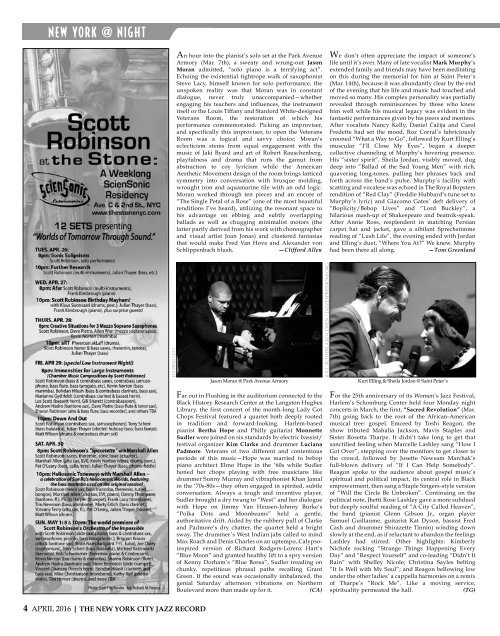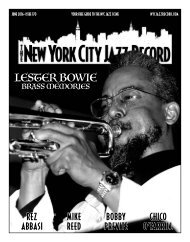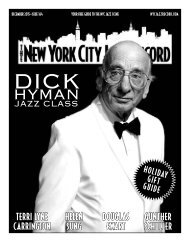You also want an ePaper? Increase the reach of your titles
YUMPU automatically turns print PDFs into web optimized ePapers that Google loves.
N EW YO R K @ N I G H T<br />
An hour into the pianist’s solo set at the Park Avenue<br />
Armory (Mar. 7th), a sweaty and wrung-out Jason<br />
Moran admitted, “solo piano is a terrifying act”.<br />
Echoing the existential tightrope walk of saxophonist<br />
Steve Lacy, himself known for solo performance, the<br />
unspoken reality was that Moran was in constant<br />
dialogue, never truly unaccompanied—whether<br />
engaging his teachers and influences, the instrument<br />
itself or the Louis Tiffany and Stanford White-designed<br />
Veterans Room, the restoration of which his<br />
performance commemorated. Picking an improviser,<br />
and specifically this improviser, to open the Veterans<br />
Room was a logical and savvy choice; Moran’s<br />
eclecticism stems from equal engagement with the<br />
music of Jaki Byard and art of Robert Rauschenberg,<br />
playfulness and drama that runs the gamut from<br />
abstraction to coy lyricism while the American<br />
Aesthetic Movement design of the room brings latticed<br />
symmetry into conversation with brusque molding,<br />
wrought iron and aquamarine tile with an odd logic.<br />
Moran worked through ten pieces and an encore of<br />
“The Single Petal of a Rose” (one of the most beautiful<br />
renditions I’ve heard), utilizing the resonant space to<br />
his advantage on ebbing and subtly overlapping<br />
ballads as well as chugging minimalist motors (the<br />
latter partly derived from his work with choreographer<br />
and visual artist Joan Jonas) and clustered fantasias<br />
that would make Fred Van Hove and Alexander von<br />
Schlippenbach blush.<br />
—Clifford Allen<br />
We don’t often appreciate the impact of someone’s<br />
life until it’s over. Many of late vocalist Mark Murphy’s<br />
extended family and friends may have been meditating<br />
on this during the memorial for him at Saint Peter’s<br />
(Mar. 14th), because it was abundantly clear by the end<br />
of the evening that his life and music had touched and<br />
moved so many. His complex personality was partially<br />
revealed through reminiscences by those who knew<br />
him well while his musical legacy was evident in the<br />
fantastic performances given by his peers and mentees.<br />
After vocalists Nancy Kelly, Daniel Čačija and Carol<br />
Fredette had set the mood, Roz Corral’s lubriciously<br />
crooned “What a Way to Go”, followed by Kurt Elling’s<br />
muscular “I’ll Close My Eyes”, began a deeper<br />
collective channeling of Murphy’s hovering presence.<br />
His “sister spirit”, Sheila Jordan, visibly moved, dug<br />
deep into “Ballad of the Sad Young Men” with rich,<br />
quavering long-tones, pulling her phrases back and<br />
forth across the band’s pulse. Murphy’s facility with<br />
scatting and vocalese was echoed in The Royal Bopsters<br />
rendition of “Red Clay” (Freddie Hubbard’s tune set to<br />
Murphy’s lyric) and Giacomo Gates’ deft delivery of<br />
“Boplicity/Bebop Lives” and “Lord Buckley”, a<br />
hilarious mash-up of Shakespeare and beatnik-speak.<br />
After Annie Ross, resplendent in matching Persian<br />
carpet hat and jacket, gave a sibilant Sprechstimme<br />
reading of “Lush Life”, the evening ended with Jordan<br />
and Elling’s duet, “Where You At?” We knew. Murphy<br />
had been there all along.<br />
—Tom Greenland<br />
da ping luo<br />
Jason Moran @ Park Avenue Armory<br />
© R.I. Sutherland-Cohen / jazzexpressions.org<br />
Kurt Elling & Sheila Jordan @ Saint Peter’s<br />
Far out in Flushing in the auditorium connected to the<br />
Black History Research Center at the Langston Hughes<br />
Library, the first concert of the month-long Lady Got<br />
Chops Festival featured a quartet both deeply rooted<br />
in tradition and forward-looking. Harlem-based<br />
pianist Bertha Hope and Philly guitarist Monnette<br />
Sudler were joined on six standards by electric bassist/<br />
festival organizer Kim Clarke and drummer Luciana<br />
Padmore. Veterans of two different and contentious<br />
periods of this music—Hope was married to bebop<br />
piano architect Elmo Hope in the ‘60s while Sudler<br />
honed her chops playing with free musicians like<br />
drummer Sunny Murray and vibraphonist Khan Jamal<br />
in the ‘70s-80s—they often engaged in spirited, subtle<br />
conversation. Always a tough and inventive player,<br />
Sudler brought a dry twang to “West” and her dialogue<br />
with Hope on Jimmy Van Heusen-Johnny Burke’s<br />
“Polka Dots and Moonbeams” held a gentle,<br />
authoritative drift. Aided by the rubbery pull of Clarke<br />
and Padmore’s dry chatter, the quartet held a bright<br />
sway. The drummer’s West Indian jabs called to mind<br />
Max Roach and Denis Charles on an uptempo, Calypsoinspired<br />
version of Richard Rodgers-Lorenz Hart’s<br />
“Blue Moon” and granted healthy lift to a spry version<br />
of Kenny Dorham’s “Blue Bossa”, Sudler treading on<br />
chunky, repetitious phrasal paths recalling Grant<br />
Green. If the sound was occasionally imbalanced, the<br />
genial Saturday afternoon vibrations on Northern<br />
Boulevard more than made up for it.<br />
(CA)<br />
For the 25th anniversary of its Women’s Jazz Festival,<br />
Harlem’s Schomburg Center held four Monday night<br />
concerts in March, the first, “Sacred Revolution” (Mar.<br />
7th) going back to the root of the African-American<br />
musical tree: gospel. Emceed by Toshi Reagon, the<br />
show tributed Mahalia Jackson, Mavis Staples and<br />
Sister Rosetta Tharpe. It didn’t take long to get that<br />
sanctified feeling when Marcelle Lashley sang “How I<br />
Got Over”, stepping over the monitors to get closer to<br />
the crowd, followed by Josette Newsam Marchak’s<br />
full-blown delivery of “If I Can Help Somebody”.<br />
Reagon spoke to the audience about gospel music’s<br />
spiritual and political impact, its central role in Black<br />
empowerment, then sang a Staple Singers-style version<br />
of “Will the Circle Be Unbroken”. Continuing on the<br />
political note, Jhetti Rose Lashley gave a more subdued<br />
but deeply soulful reading of “A City Called Heaven”,<br />
the band (pianist Glenn Gibson Jr., organ player<br />
Samuel Guillaume, guitarist Kat Dyson, bassist Fred<br />
Cash and drummer Shirazette Tinnin) winding down<br />
slowly at the end, as if reluctant to abandon the feelings<br />
Lashley had stirred. Other highlights: Kimberly<br />
Nichole rocking “Strange Things Happening Every<br />
Day” and “Respect Yourself” and co-leading “Didn’t It<br />
Rain” with Shelley Nicole; Christina Sayles belting<br />
“It Is Well with My Soul”; and Reagon bellowing low<br />
under the other ladies’ a cappella harmonies on a remix<br />
of Tharpe’s “Rock Me”. Like a moving service,<br />
spirituality permeated the hall.<br />
(TG)<br />
4 APRIL 2016 | THE NEW YORK CITY JAZZ RECORD




